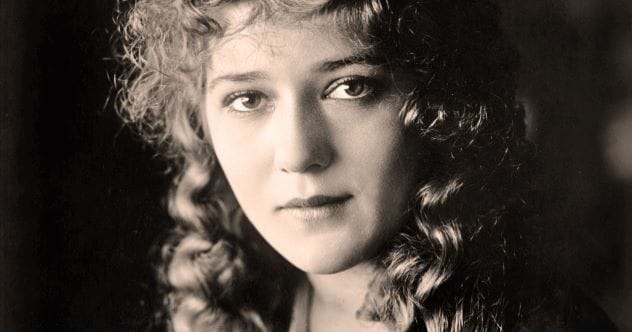Lights, camera, action! When we think of early Hollywood, certain names might spring to mind. But what about the groundbreaking women who were there from the very beginning? Talented women played huge roles in creating the movie magic we love today. They directed, wrote, produced, and starred, often pushing boundaries and challenging norms. Yet, many of these influential figures have been nearly forgotten. Let’s shine a spotlight on 10 amazing female film pioneers who truly shaped the movie industry over a century ago.
10. Alice Guy Blaché (1873–1968)
Imagine starting as a secretary at a camera company and becoming the world’s first credited female director! That’s Alice Guy’s story. In 1896, she worked for Gaumont in France. Soon, Gaumont started making movies, and Alice stepped behind the camera. Her talent was undeniable. By 1905, she wasn’t just making popular films; she was also overseeing other directors at Gaumont and creating increasingly ambitious movies.
Her 1906 film, La Vie du Christ (The Life of Christ), was a 33-minute epic. It featured 25 sets, outdoor locations, over 300 extras, and a new technique of panning the camera. After marrying Herbert Blaché, they moved to the United States. She set up her own studio in New Jersey, then the heart of American filmmaking. Over two decades, Guy Blaché made over 400 silent films, including dramas, comedies, and action movies. She often switched roles as director or producer with her husband. Sadly, legal troubles with the Edison Trust, which controlled film patents, pushed her to move to Southern California. There, her directing career faded, though she assisted on a few of her husband’s films.
9. Germaine Dulac (1882–1942)
Germaine Dulac was a true artist, often called an auteur, a director with a distinct personal style. She was France’s second female director and paved the way for experimental cinema. In 1915, she shifted from writing reviews for a feminist magazine to making her own bold and imaginative films. Across more than two dozen silent movies, Dulac focused on showing emotion through atmosphere. She used creative lighting, camera angles, and editing to achieve this.
Her 1928 film, La Coquille et le Clergyman (The Seashell and the Clergyman), was so surreal in its portrayal of a priest’s fantasies that the British Board of Film Censors banned it, calling it “objectionable if it has any meaning.” Despite this, Dulac was honored as an Officer of the French Legion of Honor in 1929. Her visual style didn’t fit well with talkies. In the 1930s, she made documentaries, focusing on everyday life to promote understanding. During World War II, under Nazi censorship, her writing on film theory stopped, but she worked to preserve seized movie prints.
8. Lois Weber (1879–1939)
Lois Weber wore many hats: director, producer, writer, and actress. Between 1911 and 1914, she made over eighty short films. Her 1913 film Suspense was groundbreaking, using close-ups and three-way split screens to build tension and show actions happening at the same time. Weber was the first American woman to direct a full-length feature, The Merchant of Venice (1914), in which she also starred.
By 1916, she was the highest-paid director in the world. Critics loved her, and audiences flocked to her films. Weber tackled bold subjects like abortion, prostitution, and birth control. Her 1915 film Hypocrites used double exposure to show a statue of Naked Truth seemingly transforming into a naked woman. Where Are My Children? (1916) was banned in Pennsylvania as “not fit for decent people to see,” but it was a box office smash elsewhere. As the Great Depression hit and interest in social issue films declined, her production company failed. She made her last film, her only talkie, in 1934.
7. Elinor Glyn (1864–1943)
While Elinor Glyn didn’t invent sex appeal, this English novelist certainly knew how to sell it. After publishing several scandalous and hugely popular romance novels about the upper class, she brought her knack for storytelling to Hollywood in 1920. Her contract was worth a fortune at the time. She adapted some of her bestselling books for the screen, including Three Weeks (1924) and His Hour (1924).
Glyn made a lasting mark on film history and language with the 1927 release of It, starring Clara Bow, who famously became known as the “It Girl.” Glyn defined “It” in Cosmopolitan magazine as “that quality possessed by some few persons which draws all others with its magnetic life force.” For movie-goers in the Roaring Twenties, “It” simply meant sex appeal, and the film’s success proved that “It” meant big money at the box office.
6. Mabel Normand (1892–1930)
Mabel Normand was a comedy queen, making audiences laugh both in front of and behind the camera. Starting as an artist’s model and movie extra, she joined Mack Sennett, creator of the Keystone Kops, in 1912. She quickly became a fan favorite with her unique style of physical comedy. Normand starred in over two hundred short films, developing her popular brand in movies like Mabel’s Stratagem (1912).
Normand also directed ten films. One notable film was Mabel’s Strange Predicament (1914), where a newcomer named Charlie Chaplin first introduced his iconic Little Tramp character. Sennett later said Chaplin learned directing from Normand. That same year, she co-starred with Chaplin in Tillie’s Punctured Romance, America’s first feature-length comedy. Unfortunately, Normand’s career suffered in the mid-1920s due to bad press from her perceived connections to major scandals. She died of tuberculosis at age thirty-seven, during the final days of silent films.
5. June Mathis (1887–1927)
June Mathis’s influence extended far beyond the more than one hundred silent films she wrote. By 1920, she was head of the scenario department at Metro Pictures (which later became MGM) and its only female executive. This powerful role meant she oversaw scripts, on-set activities, and editing decisions—much like a modern-day producer. She even supervised movies like Elinor Glyn’s Three Weeks.
Mathis had a sharp eye for talent. She cast Buster Keaton in his first feature film, The Saphead (1920), and gave Rudolph Valentino his breakout role in The Four Horsemen of the Apocalypse (1921), which became the year’s top-grossing film. She continued to write major roles for Valentino, including in Camille (1921), and also penned Ben-Hur: A Tale of the Christ (1925) for Ramon Novarro. These successes solidified her as a major Hollywood player. Tragically, her career was cut short by a fatal heart attack at age forty.
4. Mary Pickford (1892–1979)
Canadian-born Gladys Smith became “America’s Sweetheart,” Mary Pickford. Even when early silent films didn’t list actors’ names, Pickford’s charm shone through, making her one of America’s first movie stars. In 1912, she was on the cover of the first issue of Photoplay magazine. Five years later, she signed a contract paying her $350,000 for each of three films – an enormous sum back then.
But Pickford was more than just a famous actress. She used her wealth and star power to shape the movie business. Wanting more creative and financial control, she co-founded United Artists studio in 1919 with Douglas Fairbanks Sr., D.W. Griffith, and Charlie Chaplin. She often produced her own films there. Pickford also helped start the Academy of Motion Picture Arts and Sciences, the Motion Picture Relief Fund to help industry workers, and the Society of Independent Motion Picture Producers. She won Best Actress for Coquette (1929), her first talking picture, and received an Honorary Oscar in 1976 for her contributions to film.
3. Dorothy Arzner (1897–1979)
Dorothy Arzner started by typing movie scripts and worked her way up to script reader, film cutter, and editor. Her clever editing, like adding stock bullfight footage to Valentino’s Blood and Sand (1922), helped her become the only female director working within the studio system for many years. Arzner was also one of the few female directors to successfully switch from silent films to sound. For The Wild Party (1929), she invented the first boom microphone by attaching a mic to a long pole held above the actors. This improved sound quality and allowed actors to move more freely.
In 1933, Arzner joined the new Directors Guild of America and was its only female member until 1950. Over two decades, she directed more than twenty films, often telling stories about complex, independent women played by stars like Katharine Hepburn and Joan Crawford. During World War II, she made training films for the Women’s Army Corps and later taught filmmaking at UCLA.
2. Marion Fairfax (1875–1970)
After some success as a playwright, Marion Fairfax moved west in 1915 to write for the movies. She wrote forty-nine films, spanning comedy to drama, creating roles for stars like Mary Pickford and John Barrymore. She also directed her own script for The Lying Truth (1922), which bravely tackled topics like drug addiction, mob justice, and the rights of union miners.
Following the success of Sherlock Holmes (1922), Fairfax worked on The Lost World (1925), based on another story by Sir Arthur Conan Doyle. It was one of the year’s highest-grossing films. Besides writing the script, she oversaw editing, titling, and production for this pioneering film, which was the first feature-length movie to use stop-motion animation to create incredibly lifelike prehistoric creatures. While under contract with First National Pictures (later Warner Bros.), her expertise was often sought for other projects. She retired in 1926, possibly due to health issues, but lived for another four decades.
1. Frances Marion (1888–1973)
As silent films evolved, the role of the writer grew from creating basic scenarios to crafting sophisticated dialogue and narration for title cards. Frances Marion, a former journalist, learned filmmaking as an assistant to Lois Weber. Her scripts caught Mary Pickford’s eye, and she became Pickford’s favorite screenwriter and a lifelong friend. Their collaborations included Rebecca of Sunnybrook Farm (1917) and The Love Light (1921), which Marion also directed at Pickford’s request. By 1926, Marion was earning $3,000 a week (a huge sum) for her adaptations and original stories.
When movies started to talk, Marion provided the words. She wrote Greta Garbo’s first spoken lines in Anna Christie (1930) and won Academy Awards for The Big House (1930) and The Champ (1931). Her lasting legacy includes films like Dinner at Eight (1933) and The Good Earth (1937). Marion even wrote a book on her craft, How to Write and Sell Film Stories (1937). As big studios gained more power and her creative control lessened, she left MGM to become a freelancer. In her autobiography, she acknowledged the many women who helped her succeed.
These ten women, and many others like them, were true pioneers. They not only contributed their immense talents to a new art form but also navigated a male-dominated industry with courage and vision. Their stories remind us of the rich and diverse history of filmmaking and the vital role women have always played in shaping the movies we love.
Which of these remarkable women inspires you the most? Do you know of other female film pioneers who deserve recognition? Share your thoughts in the comments below!










